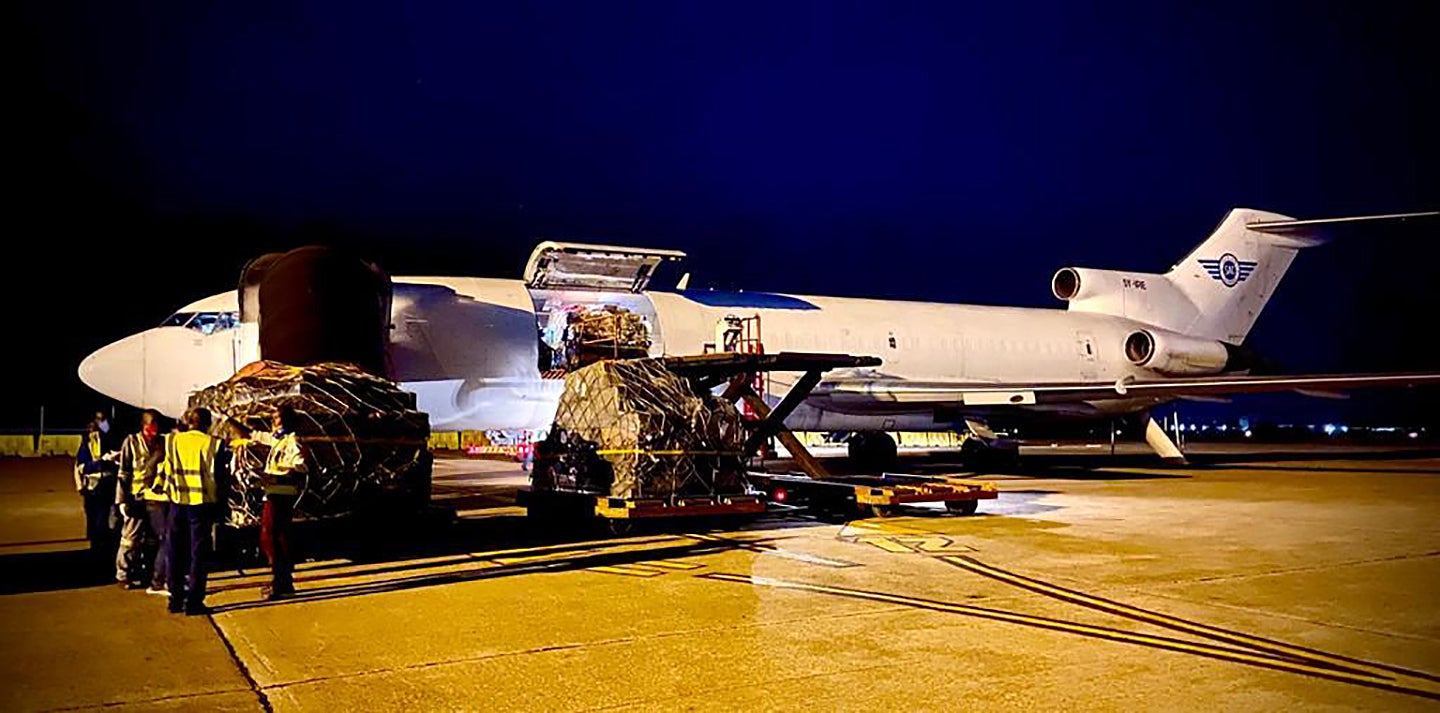Issued on: 01/09/2021 -

Neptune grass meadows have long fallen prey to boating activity with some 7,500 hectares damaged along the French coastline alone
Boris HORVAT AFP/File
Marseille (AFP)
With the world's biggest biodiversity summit set to kick off Friday in the Mediterranean city of Marseille, experts are sounding the alarm over a long-overlooked seagrass increasingly threatened by human activity.
Named posidonia oceanica -- or "Neptune grass" -- for the Greek god of the seas, the plant covers at least one million hectares (3,900 square miles) of the Mediterranean seabed from Cyprus to Spain.
The Mediterranean Network for Posidonia says the real area is probably much larger than that, with data largely unavailable for countries on the sea's eastern and southern shores.
But neptune grass meadows have long fallen prey to boating activity, with official figures estimating some 7,500 hectares in damage along the French coastline alone.
"The biggest culprit is mooring," says Thibault Lavernhe, spokesman for the Maritime Prefecture of the Mediterranean.
"When a boat drops its anchor, it hits the ocean floor and has a devastating effect... that repeats when the anchor is pulled up."
Since seagrass grows slowly -- just few centimetres each year -- the impact can take a long time to repair.
In an open letter published this month in French daily Le Monde, 10 scientists from France, Italy and Spain emphasised the essential services the humble seagrass provides "to all of humanity".
"Seagrass meadows serve as spawning beds and nurseries for species of fish living along our coasts from the most common to the rarest," they wrote.
A wide range of animals depend on them, including tiny invertebrates that are a food source to fish prized by small-scale, artisanal fishing operations.
Arnaud Gauffier, conservation director for the World Wide Fund for Nature's French branch (WWF), says the plant's ability to absorb carbon make it a crucial ally in the fight against global warming.
And he says the plants protect the coastline from erosion -- both when firmly rooted to the seabed and when they wash up on shore.
Dead blades of grass collect along beaches and mix with sand to form large banks that protect the coastline.
But for some, the phenomenon is just an unsightly inconvenience.
"Unfortunately the ecosystem is poorly understood," says Gauffier.
"Often people just think, 'Oh no, it's a dead thing on the beach that's keeping me from swimming.'"
In an effort to fight damage to Mediterranean seagrass, France has made it illegal for larger boats -- measuring longer than 24 metres (79 feet)-- to drop anchor in sensitive zones.
Spain's Balearic islands took similar measures in 2018 and enforces them with regular patrols.
Their conservation efforts, which include awareness campaigns in schools and a seagrass festival, have been highlighted as exemplary by the WWF.
© 2021 AFP
Corsica's 'ecological moorings' protect seagrass and yachts
Issued on: 01/09/2021

Marseille (AFP)
With the world's biggest biodiversity summit set to kick off Friday in the Mediterranean city of Marseille, experts are sounding the alarm over a long-overlooked seagrass increasingly threatened by human activity.
Named posidonia oceanica -- or "Neptune grass" -- for the Greek god of the seas, the plant covers at least one million hectares (3,900 square miles) of the Mediterranean seabed from Cyprus to Spain.
The Mediterranean Network for Posidonia says the real area is probably much larger than that, with data largely unavailable for countries on the sea's eastern and southern shores.
But neptune grass meadows have long fallen prey to boating activity, with official figures estimating some 7,500 hectares in damage along the French coastline alone.
"The biggest culprit is mooring," says Thibault Lavernhe, spokesman for the Maritime Prefecture of the Mediterranean.
"When a boat drops its anchor, it hits the ocean floor and has a devastating effect... that repeats when the anchor is pulled up."
Since seagrass grows slowly -- just few centimetres each year -- the impact can take a long time to repair.
In an open letter published this month in French daily Le Monde, 10 scientists from France, Italy and Spain emphasised the essential services the humble seagrass provides "to all of humanity".
"Seagrass meadows serve as spawning beds and nurseries for species of fish living along our coasts from the most common to the rarest," they wrote.
A wide range of animals depend on them, including tiny invertebrates that are a food source to fish prized by small-scale, artisanal fishing operations.
Arnaud Gauffier, conservation director for the World Wide Fund for Nature's French branch (WWF), says the plant's ability to absorb carbon make it a crucial ally in the fight against global warming.
And he says the plants protect the coastline from erosion -- both when firmly rooted to the seabed and when they wash up on shore.
Dead blades of grass collect along beaches and mix with sand to form large banks that protect the coastline.
But for some, the phenomenon is just an unsightly inconvenience.
"Unfortunately the ecosystem is poorly understood," says Gauffier.
"Often people just think, 'Oh no, it's a dead thing on the beach that's keeping me from swimming.'"
In an effort to fight damage to Mediterranean seagrass, France has made it illegal for larger boats -- measuring longer than 24 metres (79 feet)-- to drop anchor in sensitive zones.
Spain's Balearic islands took similar measures in 2018 and enforces them with regular patrols.
Their conservation efforts, which include awareness campaigns in schools and a seagrass festival, have been highlighted as exemplary by the WWF.
© 2021 AFP
Corsica's 'ecological moorings' protect seagrass and yachts
Issued on: 01/09/2021

Guests aboard the Ocean Sapphire can once again plunge into Corsican waters thanks to anchorages designed specifically to protect seagrass
Pascal POCHARD-CASABIANCA AFP/File
Bonifacio (France) (AFP)
Last year when France moved to protect Mediterranean seagrass beds by barring larger boats from dropping anchor near them, Yves-Marie Loudoux found himself adrift.
Captain of the 41-metre (135-foot) Ocean Sapphire, Loudoux remembers suddenly being unable to access his usual spots near fragile beds of so-called Neptune grass off the coast of Corsica.
"We had no solution, we were pushed to very inconvenient moorings too far from the coast," he recalls. "[Instead] we had to go to Sardinia (Italy) nearby so that people could swim."
But today his clients -- who pay some 110,000 euros ($130,000) per week to cruise the Mediterranean in style -- can once again plunge into Corsican waters thanks to anchorages designed specifically to protect seagrass.
A total of 14 ecological moorings are planned for the Sant'Amanza bay to protect some 60 hectares of Neptune grass meadows, said Michel Mallaroni, director of the port of Bonifacio and head of the 2.3 million euro ($2.7 million) project.
"The challenge is to keep the southern tip of Corsica attractive for boaters while protecting the environment," he said.
- Vital role -
Unique to the Mediterranean, Neptune grass is one of 70 species of marine seagrass growing in vast underwater meadows from the Arctic to the tropics.
The plants play a vital role in improving water quality, absorbing CO2 and exuding oxygen, and provide a natural nursery and refuge for hundreds of species of fish.
Earlier this year, it was even discovered that Neptune grass helps remove plastic from Mediterranean waters, trapping it in its leaves and forming balls that wash up on shore.

Bonifacio (France) (AFP)
Last year when France moved to protect Mediterranean seagrass beds by barring larger boats from dropping anchor near them, Yves-Marie Loudoux found himself adrift.
Captain of the 41-metre (135-foot) Ocean Sapphire, Loudoux remembers suddenly being unable to access his usual spots near fragile beds of so-called Neptune grass off the coast of Corsica.
"We had no solution, we were pushed to very inconvenient moorings too far from the coast," he recalls. "[Instead] we had to go to Sardinia (Italy) nearby so that people could swim."
But today his clients -- who pay some 110,000 euros ($130,000) per week to cruise the Mediterranean in style -- can once again plunge into Corsican waters thanks to anchorages designed specifically to protect seagrass.
A total of 14 ecological moorings are planned for the Sant'Amanza bay to protect some 60 hectares of Neptune grass meadows, said Michel Mallaroni, director of the port of Bonifacio and head of the 2.3 million euro ($2.7 million) project.
"The challenge is to keep the southern tip of Corsica attractive for boaters while protecting the environment," he said.
- Vital role -
Unique to the Mediterranean, Neptune grass is one of 70 species of marine seagrass growing in vast underwater meadows from the Arctic to the tropics.
The plants play a vital role in improving water quality, absorbing CO2 and exuding oxygen, and provide a natural nursery and refuge for hundreds of species of fish.
Earlier this year, it was even discovered that Neptune grass helps remove plastic from Mediterranean waters, trapping it in its leaves and forming balls that wash up on shore.

In 2020 France made it illegal for larger boats to drop anchor within protected Neptune grass zones
Boris HORVAT AFP/File
But the fragile ecosystems have come under increasing threat from human activity, with boat anchors a major culprit.
An estimated 7,500 hectares of Neptune grass meadows have been damaged along the French coast alone, and in 2020 the country made it illegal for boats measuring longer than 24 metres (79 feet) to drop anchor within designated zones.
"The orders by the maritime prefecture outlawing mooring in certain zones of the Mediterranean for the protection of neptune grass were historic," scientist and environmentalist Charles-Francois Boudouresque told AFP.
And with so many large yachts depending on stops along France's famed Cote d'Azur and in Corsica, the decision had a significant financial risk attached.
- Ecological moorings -
The solution: ecological moorings that "adapt to the sea floor by mimicking it" with a rough surface that "makes it easier for biodiversity to take hold", said Line Babiol of the BRL engineering firm.
She explains that the underwater components have cavities that allow fish inside and "don't impact the movement of the water".

But the fragile ecosystems have come under increasing threat from human activity, with boat anchors a major culprit.
An estimated 7,500 hectares of Neptune grass meadows have been damaged along the French coast alone, and in 2020 the country made it illegal for boats measuring longer than 24 metres (79 feet) to drop anchor within designated zones.
"The orders by the maritime prefecture outlawing mooring in certain zones of the Mediterranean for the protection of neptune grass were historic," scientist and environmentalist Charles-Francois Boudouresque told AFP.
And with so many large yachts depending on stops along France's famed Cote d'Azur and in Corsica, the decision had a significant financial risk attached.
- Ecological moorings -
The solution: ecological moorings that "adapt to the sea floor by mimicking it" with a rough surface that "makes it easier for biodiversity to take hold", said Line Babiol of the BRL engineering firm.
She explains that the underwater components have cavities that allow fish inside and "don't impact the movement of the water".

New moorings are meant to adapt to the seafloor by mimicking its surface
Pascal POCHARD-CASABIANCA AFP/File
On the surface, floating chests attached to the concrete below allow boats of up to 60 metres to safely moor -- without dropping anchors that could tear up the seagrass below.
For captain Loudoux, the anchorages are a highly-anticipated solution.
"The more moorings like this, the more people will be drawn to the sublime Corsican coasts again," he said.
According to Mallaroni, some 44 percent of leisure boats navigating off Corsica stop in Bonifacio, with the majority of vessels measuring over 24 metres.
The traffic accounted for 60 percent of the port's revenues in 2019, he said.
With additional income generated by their wealthy passengers, boats stopping in Bonifacio are a vital source of income to the town's 3,000 inhabitants.
Mallaroni says some 90 moorings are needed along the island's shores, citing the French Federation of Nautical Industries.
- Example for other countries -
On the mainland, a first ecological mooring off Pampelonne beach near Saint Tropez on France's famed Cote d'Azur should be available by 2022.
Two other sites are in development, including one in the Calanques national park between Marseille and Cassis that should be operational by 2024.
In the meantime, the seagrass zones remain off-limits to boaters -- although the authority responsible for enforcing rules has so far only issued warnings.
"Most of the boaters pull up their anchors and move to authorised zones," says Thibault Lavernhe of the Maritime Prefecture of the Mediterranean.
"But there have been several repeat offenders and eventually sanctions will have to be applied," he says, with a maximum penalty of 150,000 euros and a year in prison at stake.
Environmentalist Boudouresque meanwhile hopes that other countries with Neptune grass ecosystems will adopt similar rules -- and solutions.
"The environment has no borders," says Boudouresque.
"Other Mediterranean countries should get inspired by these protective measures."
© 2021 AFP
On the surface, floating chests attached to the concrete below allow boats of up to 60 metres to safely moor -- without dropping anchors that could tear up the seagrass below.
For captain Loudoux, the anchorages are a highly-anticipated solution.
"The more moorings like this, the more people will be drawn to the sublime Corsican coasts again," he said.
According to Mallaroni, some 44 percent of leisure boats navigating off Corsica stop in Bonifacio, with the majority of vessels measuring over 24 metres.
The traffic accounted for 60 percent of the port's revenues in 2019, he said.
With additional income generated by their wealthy passengers, boats stopping in Bonifacio are a vital source of income to the town's 3,000 inhabitants.
Mallaroni says some 90 moorings are needed along the island's shores, citing the French Federation of Nautical Industries.
- Example for other countries -
On the mainland, a first ecological mooring off Pampelonne beach near Saint Tropez on France's famed Cote d'Azur should be available by 2022.
Two other sites are in development, including one in the Calanques national park between Marseille and Cassis that should be operational by 2024.
In the meantime, the seagrass zones remain off-limits to boaters -- although the authority responsible for enforcing rules has so far only issued warnings.
"Most of the boaters pull up their anchors and move to authorised zones," says Thibault Lavernhe of the Maritime Prefecture of the Mediterranean.
"But there have been several repeat offenders and eventually sanctions will have to be applied," he says, with a maximum penalty of 150,000 euros and a year in prison at stake.
Environmentalist Boudouresque meanwhile hopes that other countries with Neptune grass ecosystems will adopt similar rules -- and solutions.
"The environment has no borders," says Boudouresque.
"Other Mediterranean countries should get inspired by these protective measures."
© 2021 AFP



































